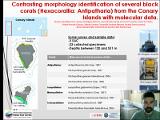Por favor, use este identificador para citar o enlazar a este item:
http://hdl.handle.net/10261/348751COMPARTIR / EXPORTAR:
 SHARE
BASE SHARE
BASE
|
|
| Visualizar otros formatos: MARC | Dublin Core | RDF | ORE | MODS | METS | DIDL | DATACITE | |

| Título: | Contrasting morphology identification of several black corals (Hexacorallia: Antipatharia) from the Canary Islands with molecular data |
Autor: | González-Porto, Marcos CSIC ORCID ; Martín-García, Laura CSIC; De-la-Torriente, Ana; Falcón, Jesús; Serrano, Alberto; Dionis Insensé, Noemi; García-Mañé, Bertín; Estil-las, Clara; Martín-Sosa, Pablo | Fecha de publicación: | 29-may-2023 | Resumen: | Antipatharians, also known as black corals, form three-dimensional habitats with high biodiversity from the infralittoral to the bathyal rocky bottoms of The Canary Islands. About thirty species belonging to this group have been found in this archipelago and surrounding areas. However, the taxonomic identification of some species still seems confusing, mainly due to their phenotypic plasticity. Therefore, the combination of morphological and genetic studies to support their identification is required. During a survey aboard the R/V Ángeles Alvariño conducted in 2022 in Special Areas of Conservation (SAC) at La Palma and El Hierro, the western islands of the Canary Archipelago, 23 specimens of black corals were collected with a remote operated vehicle. These samples, collected at depths between 120 and 531 m, were identified using morphological characters and molecular techniques (amplification and sequencing of 28S rRNA gene fragment). Although the results confirm the coincident morphological and molecular identifications for species of the genera Leiopathes or Antipathes, they show certain discrepancies in some taxa between the two approaches. Specifically, morphological features such as size, arrangement of the polyps and the shape of the spines, assign three samples to two different genera Antipathella and Tanacetipathes, while sequence homology to Genbank available sequences for Antipatharia and the phylogenetic analysis identified them as the same taxa. On the other hand, five collected specimens morphologically identified as Stichopathes spp. appear in two separate clades in the phylogenetic tree, being assigned to different genera by the molecular method, which confirms that the genus Stichopathes is a polyphyletic taxon, as previously reported (Bo et al., 2012). Further confirmation of the results presented here will be performed using mitochondrial markers. This study greatly contributes to clarify black corals taxonomy in The Canary Islands. | Descripción: | Presentación realizada para el 8th International Symposium Deep-Sea Corals, celebrado entre los días 29 de mayo y 2 de junio de 2024 en Edimburgo (Escocia). | URI: | http://hdl.handle.net/10261/348751 |
| Aparece en las colecciones: | (IEO) Comunicaciones congresos |
Ficheros en este ítem:
| Fichero | Descripción | Tamaño | Formato | |
|---|---|---|---|---|
| Gonzalez_Porto_Contrasting morphology identification of several black corals.pdf | 494,97 kB | Adobe PDF |  Visualizar/Abrir |
CORE Recommender
NOTA: Los ítems de Digital.CSIC están protegidos por copyright, con todos los derechos reservados, a menos que se indique lo contrario.
